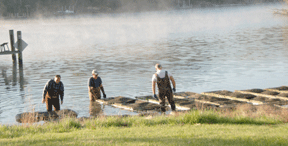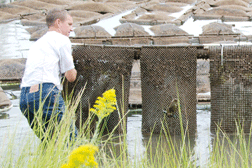Farming the Waters
Can aquaculture save an industry — and the Bay?by Sandra Lee AndersonThis story started when I met the ranchers. They wear chaps for protection, and they work on ranches, but they’re not wrangling cattle. They’re raising oysters. Richard Pelz, the trailblazer, brought oyster ranching to Maryland. At Circle C Oyster Ranch, on St. Jerome Creek in St. Mary’s County, he proved that floating oysters in low salinity protected them from killer parasites while providing them rich grazing. The oysters responded by growing plump and marketable within 18 to 24 months. Sixteen years later, Pelz-style ranching may be our best hope for restoring oysters in Chesapeake Bay. I got to know the ranchers through my husband. Charlie’s environmental group, the Patuxent River Chapter of the Coastal Conservation Association, teamed up with Circle C to farm its own oyster floats. The goal is to see if aquaculture — that’s farming as opposed to gathering wild oysters, as Bay oystermen have always done — can help save our native eastern oyster, Cassostrea virginica.
We Should Have ListenedWe wouldn’t be in the fix we’re in if we had listened to William Brooks back in 1896. He could be writing for us today: “Our method of managing the oyster industry so far has been a failure,” he wrote in The Oyster [reviewed in Bay Weekly’s 2008 Summer Reading Companion: No. 27: July 3]. By Brooks’ time, we had already overharvested reefs once so high — 20 to 30 feet — that Capt. John Smith called them hazards to navigation.The harvest of 1905 was a quarter of 1885’s. Brooks’ radical solution was aquaculture. But nobody listened. 21st Century Oyster RanchingA century later, Pelz embraced and improved on Brooks’ solution with his trademarked oyster floats. One of about six commercial float-ranches in Maryland, he’s the only one on the Western Shore selling oysters destined for dining. Oyster ranching has its challenges, from permitting to storms to contamination to oyster rustlers. Yet for two years, Circle C has been making money. Our floats are tethered at Bob Parkinson’s place on St. Thomas Creek in St. Mary's County. He buys seed oysters from Circle C at about six months old, when they’re the size of a quarter. Usually, they’re the Lineback oyster that Pelz has developed. Parkinson floats them for about 11 months. When they’re three to six inches, he trucks them back to Circle C and sells them for a profit of $100 per float. Circle C sanitizes the oysters in a stream of clean water before putting them on the market — to restaurants, wholesale and direct to the public. Dockside, oysters sell for about 37 cents for each cocktail oyster and $1.13 for jumbos.
Oysters at WorkThe ranchers are also making an environmental profit. While their oysters are preparing themselves for our palates, they’re also hard at work cleaning the Bay. The water under Pelz’s floats has changed from a murky mess to clear, exposing rippled brown sand and clay. Once there were no fish; now spot, croaker, white perch and weakfish flourish. Kingfishers, loons, bald eagles, blue herons, snowy egrets and a bluebill duck show up to dine on the fish. Nature has returned. Raising his own oysters, Parkinson hopes to see his beach go from muck and mud to sand and grass. Pelz and affiliate ranchers like Parkinson are also contributing to scientific studies about their oysters. Pelz showed me a map that displayed red for the presence of the disease Dermo throughout lower St. Jerome Creek — except in the wide green swath around his ranch Ranchers at WorkAt Parkinson’s ranch, where we pasture with his 60 floats, the tenderfoots of the Coastal Conservation Association got dirty hands and wet feet. Our 16 floats — each a 10-by-three-foot frame of six-inch PVC donated by Circle C — came furnished with five hard plastic mesh bags where our oysters will grow. Into each bag, we shoveled about 200 two-and-a-half-inch-long oysters. We closed the bags with a cord cinched around the PVC frame. Then, the men walked the floats — each filled with 1,000 oysters — into the water, oyster side down, and tethered them up the creek away from the bank to avoid fecal contamination from forest animals and possibly septic systems. Every three weeks, we returned to flip the floats. Suspended out of water, the oysters can survive a few days, but interloping barnacles and clinging algae cannot.
In 18 months, the oysters will be large enough to be freed from the floats and released in an oyster sanctuary where harvesting is forbidden. There, they can age gracefully, clean the water, grow baby oysters, begin building a reef — and saving the Bay. That’s the point of our ranching experiment. But it’s not the whole story, for oysters or for Bay culture. The Failing Oyster EconomyOysters play a critical role, perhaps the critical role, in sustaining the life of the Bay. They also play a key role in sustaining the Bay’s historic water-based economy. If oysters sink, so does the oyster economy. Just as oysters are fewer, so are the men who harvest them. Two thousand oystermen worked Maryland waters in the 1980s before the latest blow to Chesapeake oyster survival, the rampaging diseases MSX and Dermo. Today, we’re down to about 529 oystermen. A day’s work in 1980 was rewarded with about 14 bushels. By 2001, even with fewer harvesters, the same work yielded only eight bushels. An oysterman could expect $7,900 for a year’s effort in 1980, but only $5,300 in 2001. The state’s been trying to halt the oyster’s downward spiral — with little to show for a lot of effort. Since the 1960s, Maryland has sustained the oyster industry as a put-and-take fishery. We’ve paid watermen to dredge shell and dump it on restoration sites. There, best case, floating natural or hatchery-grown spat (larval oysters beginning to develop their shell) hook on. This year, 485 million oysters were planted in the Bay.
A year after planting, when the oysters had reached four inches, the oystermen returned to the public bars to harvest the oysters they were paid to plant. The program cost the state from $32 to $225 for a bushel of oysters that sell at dockside for only $30. Put and take didn’t make economic sense. Or environmental sense. “The native oyster is so low that it is likely that we cannot achieve our economic and ecological goals,” Tom O’Connell, director of Fisheries for the Maryland Department of Natural Resources, told Bay Weekly. “And the ecological comes first.” Time has come for a change. Environment FirstLast year, the Oyster Advisory Commission convened to figure out a better way to spend the state’s oyster money. The panel — environmentalists and scientists and people who make a living from oysters — must recommend whatever it takes to keep native oysters reproducing and filtering the Bay. Even if it means turning oystermen from fishermen to farmers. The M word — for a harvesting moratorium — is being spoken only in hushed tones, as alternatives are weighed, among them aquaculture, allowing harvesting only on leased reefs and, unlikely as it now seems, importing the non-native Asian oyster. These are big issues, and the direction for oysters may be set in the near future. This month an Environmental Impact Statement, based on scientific studies conducted since 2004, will finally be published. After that study and its 60-day public comment period, Maryland’s Oyster Advisory Commission will make its recommendations. Bill Eichbaum, chairman of the commission, thinks it’s time to follow William Brooks’ 19th century advice. “Globally,” Eichbaum told me, “aquaculture is a steadily growing and significant piece of the picture, and that trend should play out here.” Nor can he see how, for now at least, a wild oyster population can survive harvesting. “We have to transition to a vision where within two decades,” he says, “we’ll have a large, healthy population of oysters and, separately, a vital oyster industry based on modern technology and industry.” Riding into the FutureCharlie, the Patuxent Coastal Conservation Association and I might be at the right place at the right time. In our tended floats, healthy oysters are growing and cleaning the waters. Over the past five months, they’ve begun to bulge their bags, and we’ve added 15 more floats. We are demonstrating that aquaculture is doable, and the oyster ranchers are proving it is profitable.
|
|||||||||||
|
|
|||||||||||
|
© COPYRIGHT 2008 by New Bay Enterprises, Inc. All rights reserved.
|






